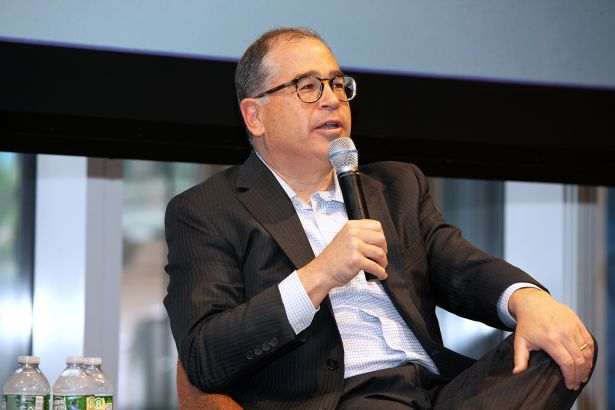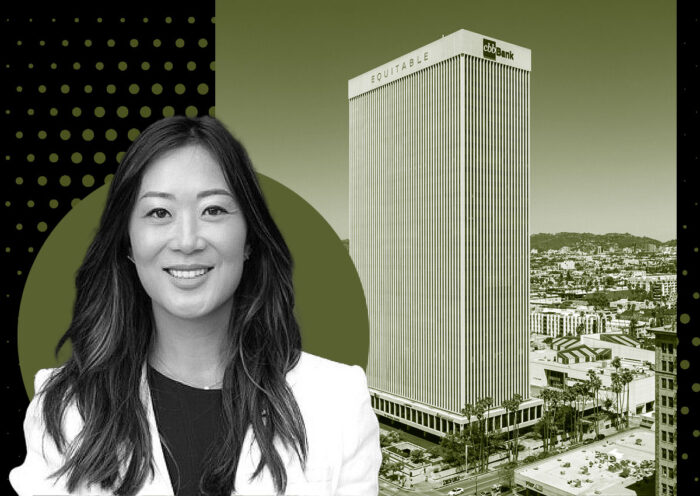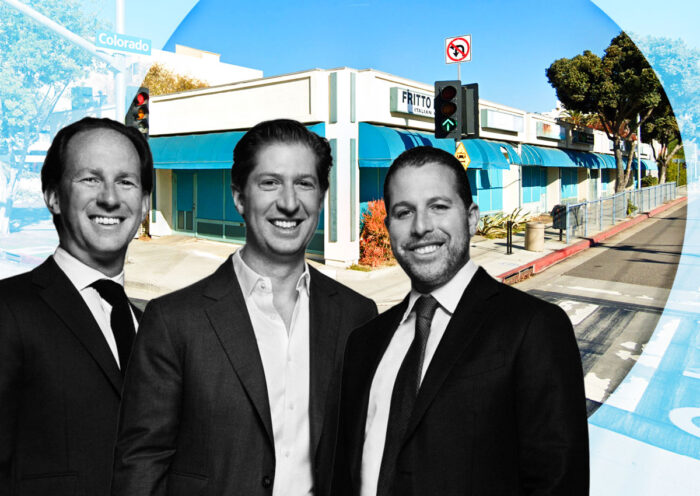Maria Torres-Springer, New York’s deputy mayor of housing, economic development and workforce, opened the forum by summarizing the various initiatives the administration of Mayor Eric Adams has put forward to improve the city’s real estate climate, much to the delight of the audience.
Torres-Springer cited the administration’s “City of Yes” program, which proposes numerous reforms to existing building codes and zoning laws. These include expanding small business licenses, creating new zoning to foster warehouse development, allowing new retail in residential areas, expanding the map of where life sciences labs can operate, and giving developers the ability to increase commercial building density so long as it’s used for affordable housing purposes.
She even said that previous zoning laws have “made it illegal for businesses” to maximize their existing office space in New York City.
“Here’s the reality: The zoning code was written 60 years ago, and it’s time for a change,” said Torres-Springer. “And we’ve undertaken some really interesting work to make sure that happens.”
Top of mind for the Adams administration is working to improve New York City’s core business districts — Midtown, Lower Manhattan and Downtown Brooklyn — and turn them into 24/7 environments that are simultaneously livable and workable, according to Torres-Springer.
The next panel, moderated by Jonathan Mechanic of law firm Fried Frank, featured a discussion with Glen Weiss, executive vice president of office leasing and co-head of real estate at Vornado, and Bruce Mosler, chairman of global brokerage at Cushman & Wakefield (CWK).
Both Weiss and Mosler praised the recovery of the New York office market (65 percent employee attendance at least three days per week, per Weiss), giving special commendations to the city and state political system for reducing crime, improving urban centers, and passing legislation friendly to real estate interests.
“We don’t talk often enough how the deputy mayor, the mayor, the governor work together to really solve problems,” said Mosler. “The governor has put money in her budget, and the mayor himself has a plan to identify and provide incentives for affordable housing, and there’s no question in my mind it will reduce the obsolescence in some of these buildings.”
Mosler remarked, however, that Cushman’s office leasing this year is trending far lower than the 9 million square feet the brokerage delivered in both 2022 and 2023, and that the present dearth of anchor tenants has caused the cost of financing to go up, and office portfolio values to dwindle.
“You’re looking for a couple hundred thousand square feet on behalf of the client, and the options are becoming more and more limited in this highly bifurcated marketplace,” he said.
Vornado’s Glenn Weiss PHOTO: Greg Morris
But, in a surprising counterintuitive turn, Vornado’s Weiss argued that it’s actually good that the city’s office pipeline lacks so much in the way of new development, calling that lack “a good thing for the supply and demand equilibrium” heading into the next 18 to 24 months, as it forces tenants and landlords hunting for higher-quality office space to make use of the existing supply.
“I don’t think now is the time to begin building new buildings, particularly on [speculation],” Weiss said. “You need a 1 million square-foot anchor tenant, construction financing rates are too high, so it’s just not the right time to start going up with a building unless it’s perfect.”
As for those elusive anchor tenants, Weiss couldn’t help but note that some of the biggest names in business have committed themselves to New York recently.
“Forget Miami — it’s all about New York for Ken Griffin, and for Jamie Dimon it’s all about New York,” he said. “Companies are out there saying we’re going to stay in New York, and we believe in New York.”
The next panel, moderated by Dan Berman, a partner at Kramer Levin Naftalis & Frankel, focused on CRE capital markets and what sponsors can do to attract high-quality tenants while simultaneously finding opportunities to pounce on distressed assets.
Brian Feil, principal of the Feil Organization, declared that while big deals get all the headlines, the majority of New York City office leasing involves smaller tenants who can’t afford $150-per-square-foot rents. He admitted that his firm “tries to temper” what it does to improve basic building fundamentals of its portfolio without spending $200 per square foot to attract each tenant.
“There are hundreds of tenants that need quality assets and good space that a landlord can deliver,” Feil said. “We’re looking at the basics: elevators, lobbies, corridors, the bathroom, the air condition, the roof structure, stuff in the basement, and then prepping the spaces.”
Russell Young, executive vice president at RXR, broke down the office sector into three categories. There are the tier one assets, like 1 Vanderbilt, Hudson Yards, and other top-of-the-line product. Then there are Class B assets, side-street assets, and office assets that need to be converted into something else — these are the bottom. In the middle is the vast majority, which are Class A buildings with varying levels of quality and can be financed accordingly.
“As it relates to our focus going forward, we’re focused on the upper segment of that middle branch: Class A assets that have great locations,” explained Young. “Contrary to noise, we’re seeing leasing in that segment.”
Christina Chiu, president of Empire State Realty Trust, echoed these sentiments, and called it “a misconception” to believe that every $200-per-square-foot rent or topline product does well, as not every tenant can pay those prices (nor do they want to). Instead, Chiu said “landlord efficiencies” was the X factor that determines whether an office building fails or succeeds in this current dislocation.
“Tenants want the best they can get,” said Chiu, citing the value proposition dilemma. “So the onus is on the landlord to have buildings that are well located, energy efficient, have good floor plates and amenities. The days of ‘Build it and they will come’ are over.”
Panelists discuss office’s relation to capital markets. Photo Credit: Greg Morris
The panel also touched on the challenges commercial mortgage-backed securities (CMBS) present to the collateralized debt world, as so many sponsors find their assets tied to the fortunes of complex securities instruments used during low interest rate environments that are long gone.
“It will just be a very slow, painful process to work through some of these problems,” said Fiel. “CMBS was the soup du jour of 2008 to 2018. It was cheap debt, everyone was doing it, and we’ll spend several years trying to unwind it.”
Finally, Chiu observed the differences between operating as a public real estate investment trust (REIT), where shareholders sign off on any runway, compared to private companies – particularly when it comes to office players attempting to expand outside their traditional asset class and into multifamily.
“The REIT market can be a little more antiquated in terms of staying in your own lane, in terms of sector,” said Chiu. “It can be less patient with investments that can generate long-term opportunity, but aren’t necessarily near-term, earnings-contributing types of investments.”
Before a short break, attendees were given a keynote interview between Commercial Observer Editor in Chief Max Gross and Spencer Levy, CBRE (CBRE)’s senior economic adviser. Levy opened by reiterating that there is a shortage of office space in the highest-quality markets and submarkets for tenants of any size, but he suggested that this supply crunch will play in New York’s favor as the city aims to reimagine its central business districts post-COVID.
“From an investment standpoint, what will make New York City durable over the long term is that New York will reinvent itself. It has been doing this for 250 years,” Levy said. “I think the definition of a good thing is a sustainable thing, a productive thing, and moving forward with growth. If no new construction means those three things, then, yes, I’m for it.”
But, if there’s a catch to this supply crunch for capital markets players, it’s the interest rate paradigm. Levy bemoaned the unpredictability of the Federal Reserve — first by telegraphing a recession in 2023, then by bailing out regional banks last spring, and now in holding rates at their highest levels in 23 years — which has stoked the fears of bondholders and generated the highest Treasury yields since George W. Bush was in the White House.
“The market is adjusting to the new normal of higher interest rates but we still need lower interest rates, we need the 10-Year [Treasury] to get lower,” said Levy. “There has to be a massive basis reset in order to do a lot of things in office here in New York. A couple hundred basis points could be 30 percent or 40 percent [improvement in value].”
CBRE’s Spencer Levy holds court. Photo Credit: Greg Morris
As an economist, Levy couldn’t simply end on a negative strain. He spoke to the need for American cities — Milwaukee, Detroit, St. Louis, even New York — to take a page out of Chicago’s Fulton District and reinvent obsolete commercial property into new multifamily.
“Multifamily is the solution to saving cities. They need to have a greater mix of uses,” said Levy. “You go to the Fulton Market in Chicago, you have the mix of the best office, the best multifamily, and best retail in a submarket that didn’t exist 10 years ago, and that’s precisely what we need in CBDs in New York and elsewhere.”
After a networking break, Philip Rosen, partner at Weil, Gotshal & Manges, hosted a seminar centered around whether recent workplace improvements have pointed to an uptick in office attendance.
Jake Nathan, senior vice president at Brookfield Property Group, said that every metric in his firm’s office portfolio has been trending upward and to the right compared to the last 24 months.
In New York “tenant demand is up 15 percent year-over-year, versus 3 percent for the rest of the major markets,” said Nathan. “The tenants are clearly coming back to market, they’re engaging in the market, and the economics are corresponding, but it’s a more complicated story.”
Michael Gerazounis, managing principal and CEO of MGE, a CRE engineering firm, discussed the choices his office clients face on designing space: whether to create open layouts, build break rooms, or continue the traditional cubicle format. He said that he personally prefers the privacy of a personal office.
Kyle de Bruin, development director of Leesman, a company focused on the future of workplaces, said that since employees have changed their perception on commutes post-COVID, it will be up to employers make it worthwhile for them to continue to come to the office.
“From an optimistic perspective … what we’re seeing is occupiers are investing in spaces in the right way and figuring out more ways for employees to use those spaces,” said de Bruin. “But how can you provide the best experience going forward? It’s the piece of the puzzle we’re focused on to create a holistic and habitable experience for organizations.”
After some awkward banter with the moderator about the relationship between public safety and New York City’s government, Emily Marcus, vice president at the New York City Economic Development Corporation, defended the agency’s role in improving the city’s office market amid generational distress.
Marcus pointed to M-Core, the Manhattan Commercial Revitalization Program, that aims to help Class B and Class C office properties make capital improvements to attract tenants.
“It’s a competitive program where we support lower-performing buildings with higher levels of vacancy to make significant, transformative investments that create the quality of space tenants are looking for in this market,” explained Marcus.
Staying on the topic of driving workplace demand, the next panel tackled the tenant’s perspective in the return-to-office puzzle. Here, Nina Roket, co-managing partner and chair of the commercial leasing practice at Olshan Frome Wolosky, asked what needs to be done to make employees excited about coming back into the office.
“If you surveyed most employees and asked them what they wanted, they’d say flexibility, choice and experience,” said Ryan Simonetti, CEO and co-founder of Convene. “All the pandemic did was shift the dynamic of power where that went from a want and potentially a need to, ‘Well, I have it now.’”
Convene’s Ryan Simonetti talks about tenants. Dean Kaufman
Marisa Gadlin, senior vice president at Rockefeller Group, cautioned against painting a broad brush on return-to-office by noting that attendance figures are “building and tenant specific.”
“Across our portfolio, the buildings that have more intensive finance uses, they’re in the office four to five days per week,” she said. “Law firms are dependent on mandates. What a mandate means is up for interpretation, but, in our portfolio, some of our buildings are packed at normalized occupancy — not on Fridays, but Monday through Thursday.”
Bryan Zenchyk, COO of Morning Calm Management, called it “the million-dollar question” when Roket asked him what needs to be done to incentivize return, but answered in an unorthodox manner by citing pickleball as one potential carrot to dangle before employees.
“I think the average person wants to come in for some level of building connections [with others] and learning and advancing themselves,” said Zenchyk. “We’re hearing from people, ‘Hey we just need a place to go build relationships,’ and playing pickleball is a way to build relationships. It’s not just, ‘Hey, let’s grab a drink,’ or ‘Let’s grab coffee.’”
The last panel of the morning involved a discussion among three top building executives in New York City and an engineer. It explored the relationship between brokers, tenants and owners.
Alyssa Zahler, managing director of leasing at Two Trees, recalled how the Walentas family, which founded her firm, curated the Dumbo neighborhood in Brooklyn basically from scratch by buying 13 derelict buildings for $6 per square foot in 1979. While Two Trees didn’t know what Brooklyn would become back when the area was abandoned, the firm made the proactive investments necessary to prepare for a wave of future demand.
“We invested a lot of money into the parks and into the streets there, which obviously we wouldn’t see [return-on-investment] on for many years to come, and we did deals at $3 to $5 per square foot,” Zahler said. “Eventually, we were able to get the city to come down, and, in 2000, we got lucky: Tech companies were interested in old buildings, and that’s when Dumbo took off.”
In the same vein, Jim Somoza, managing director of Industry City, spoke to the challenges and opportunities he’s faced securing tenants for the 6 million-square-foot adaptive reuse development in Sunset Park, Brooklyn, that combines office, industrial and retail across 35 acres of former warehouse property.
“We had a project that really had nothing. There was no retail, very little office, 1,500 people working in 6 million square feet — you could work for hours and not see a person in the beginning,” he explained. “We wanted to do something that was fun, something that would attract people, and we wanted to be a destination and do some crazy things people would enjoy.”
Well, Somoza certainly has walked outside the box in Industry City: He leases 600 square feet to an honest-to-god blacksmith, has cultivated an outdoor Japanese garden, opened numerous art galleries, and built a Bangkok-themed Thai restaurant.
“You have to put in a lot of work upfront, get to know people, get to know the operation, know who they are, and know in your head that this is going to resonate with people,” said Somoza.
William Elder, executive vice president and managing director of RXR’s New York City division, said that office leasing in a metropolis like New York comes down to neighborhoods, as areas like Grand Central Terminal tend to be “more law firm-, financial services-oriented,” while the Lower Manhattan Manhattan and Brooklyn areas are more for “gritty, city-type” tenants.
“At some point we get paid for all this, but it’s a lot of work, and at the end of the day you make your asset more valuable by attracting the people who want to get in there,” Elder said. “But you’ve got to really understand your customers, you’ve got to really dig in. Putting something glass and steel in front of one group won’t work [with others].”
And, in perhaps the biggest change in the last decade, sustainability and environmental footprints are now top of mind when tenants consider leasing office space, according to Corey Letcher, an executive and engineer at Trane Technologies, a manufacturing firm specializing in HVAC systems.
Letcher said that 10 years ago, “sustainability was a broken window on someone’s website,” but today the largest CRE tenants are putting sustainability at the forefront of what’s important to them and how space is being utilized.
“We’re seeing some tenants, especially buildings that have large anchor tenants, they are becoming part of the project conversations upfront,” said Letcher. “They want to know, ‘Hey, if I’m signing a 15- to 20-year commitment, what are you doing to have a sustainable footprint here?’ ”
“It’s definitely been a market shift in terms of what’s important to folks and why it’s important to them,” he added. “And it’s happening more and more.”
Brian Pascus can be reached at bpascus@commercialobserver.com















